Custom and traditions in Azerbaijan
National traditions are well preserved in Azerbaijan. They have a long history, namely originates from the formation of the Azerbaijani people.There are several traditions in Azerbaijan, some customs and traditions differ from region to region .
Tea Culture
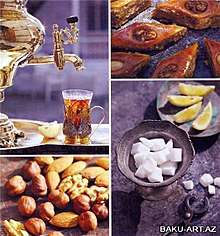
Serving tea to guests is one of the ancient traditions in Azerbaijan. Azerbaijani people usually prefer to dunk a piece of sugar into the tea, then bite a piece and sip their tea instead of adding sugar into it. Serving tea just before the main meal with different kinds of jam, (strawberry, fig, apricot, blackberry, cherry, walnut), sweets and fruit deserts is considered to be a symbol of hospitality.[1] The tea table is not complete without lemon.[2] They served hot tea in cups or Armudi Glass (pear-shaped glass). Armudi Glass is a symbol of tea ceremony. The main point in tea preparation process is water boiling technique. The smell and taste of fresh samovar tea (Samovar is a metal container for water boiling purpose) is unique and cannot be compared with other tea smells. An Azerbaijani family of four members uses approximately 500gr of tea monthly and about 6-8kg yearly.
Tea is served in any ceremony in Azerbaijan regardless whether it is funeral or wedding. Whether tea is sweet or sugarless shows the decision or at least the opinion of parents of girl about the marriage on the matchmaking process. Sugar is the key indicator of their agreement.[3][4][5]
Nowruz Holiday in Azerbaijan
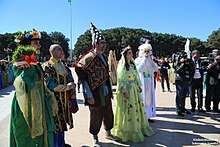
Azerbaijanis start holiday 4 Wednesdays before 21st of March which is the symbol of winter's end and the coming of the New year. They are called Water Wednesday, Fire Wednesday, Earth Wednesday, Wind or Last Wednesday.[6] Nowruz holiday consists of ceremonies and traditions. People start to clean house, paint eggs, sprout up semeni, make national pastries such as shekerbura, pakhlava, shorgoghal, badambura and a great variety of national cuisine[7]. It is tradition to light a candle matching the number of family members. One of the main attributes of Nowruz is egg. Many nations considered that egg is symbol of life. Each egg colour has its own meaning. Egg painted Red color - summer, Green Color – Spring, Yellow Color- autumn, Non-color egg means winter.
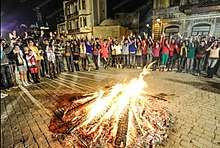
Symbolic characters of Nowruz are manifested by Kechel, Kosa and Bahar gizi (Spring girl). Their meanings are: The period prior to Nowruz is embodied by Kechel as well as to indicate the renewal of nature, the fertility symbol is Kosa, while landscaping of nature is represented by Bahar gizi.
At night, everyone should jump over bonfire for 7 times while telling special. After holiday people visit adults and elder people to congratulate their holiday and give some holiday gifts. And people who quarreled got reconciled on that day.[8][9][10]
Hat throwing
Another tradition is "papagatdi". children knock on the neighbors' or relatives’ doors and leave behind the door their hats or a little basket and they hide. And secretly wait for candies, pastry and nuts. People never give it back empty.
Semeni
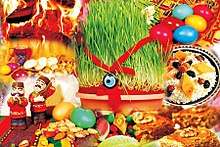
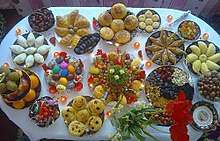
Semeni is one of symbols of Nowruz. Usually Semeni is made from seed of wheat. It must be sprout up in every home on Nowruz. The first sneak of the spring shows a revival of nature. If it is going green, it means this year will be fertile.
Traditional Nowruz beliefs
There are several beliefs for young girls about telling fortune in Nowruz.[11]
Eavesdropping
People overhear conversation behind the doors of their neighbors in the afternoon. Then girls try to tell stories about their fortune and make guesses based on the first heard word if their wishes come true. That is why everybody tries to speak pleasantly on that day. For example, if somebody says “turn on light”, it means everything will be good. On contrary, if expressions like “turn off”, “damn it” etc. are overheard it clues about negative consequences.
To eat salty cake
When it's sleeping time, they must eat extremely salty cake that is prepared in advance. It is not allowed to drink water. If they have a dream of someone handing them over a glass of water, he will be her future husband.
Apple soothsaying
People also eat an apple on that day. When they go to bed they put 10 apples’ seeds under the pillow and they will have a future husband in their dream.[12]
Wedding traditions
Girl liking or seeing
If boy and girl liked each other, first of all, they must ask the opinion of parents. According to traditions, the boy's mother and one of the close relatives visit girl's home to discuss with her parents the relationship between their children. Then fathers of both side meet. Usually, girl's father doesn't agree for the first time and says the following: “Qız qapısı, şah qapısı” (meaning is “Maiden's door is the door of the king, that is why you must come several times for my agreement”) “I will say final decision after I discuss it with my daughter and wife’’. When father asks from his daughter about this relationship, the daughter must keep silence. Silence means agreement. This is because the main decision belongs to adults and elders.[13]
Match-making

Boy's Father invites close relatives such as uncles and aunts to the home. After consulting they decide to go to the girl's home for match-making. Then, they tell girl's mother that they plan to go to their house for match-making on a certain day. On that day, everyone drinks sweet tea after the final agreement between two families.
Nişan (Engagement)
After a few months, Boy's family brings engagement ring, one shawl and lots of sweets to the girl. The close relative of boy (it could be the brother, brother-in-law etc.) fixes a ring on her finger and puts shawl in girl's shoulder. According to Azerbaijani traditions, it is believed that if engaged girl lays her hand on head of single girls they can also get married soon.
Holiday gift
Boy's family must bring gifts in all holidays until the wedding ceremony, Novruz Holiday gift is more interesting than the other ones. Holiday gift should be brought on last Tuesday of Novruz. The red dress, or shawl, and jewelry, horned rams with henna and red band on head are brought for bride. They also bring a pie, pakhlava, nuts - hazelnuts, innab, date filled trays decorated with candles and samani.
Dorwy
Girl's mother prepares dowry for her daughter for several years. Several days before wedding ceremony, they bring dowry of the bride to boy's home. Dorwy[14] is consist of at least bedroom furniture, home accessories and personal belongings of girl. Some of the relatives of girl comes to decorate girl's room. Mother-in-law of girl gives the gift to her for decorating the room.[15]
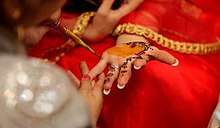
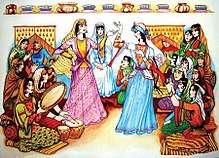
Kebin (Religious marriage registering)
Religious marriage registering takes place a few days before the wedding ceremony. One person as witness from both sides must present on this registering. After the establishment of the Soviet Union in Azerbaijan, the public has started preferring the form of marriage by the state. Usually it is registered by Mullah. People were giving money and one sugar loaf which was 8 kg in weight.
Xinayaxdi(Henna Night)
Girls gather in one of the rooms. One of bride relatives takes henna and starts dancing in the middle of the room. Then she brings a tray and an empty box and puts them in front of the one of groom relatives. This relative put money into the empty box and takes the henna. She comes to the bride with dancing then the bride's fingers and feet are smeared in henna. Then henna is brought in front of everybody. Everybody smears henna and gives namar. Then the jewelry that the groom's relatives brought was presented to everybody.
Meanwhile, a girl from bride side brings a "2 color" tea to the groom and his friends. They also drink tea and put a namar (according to Azerbaijani traditions, namar is candle, money or little gift which is collected in wedding, or engagement ceremony) on an empty tray. One of the girls brings the henna and the boys are sliding their little finger into the henna.[16]
Wedding
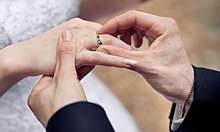
The bride writes the names of her single friends under her shoes on the wedding day. According to the tradition, when the wedding is over, the person whose name is deleted will be the next bride. The groom, his friends and relatives come to the bride's house for carrying bride to wedding place, in a fancy and luxurious car decorated with bands and flowers. They carry a mirror and candles that are believed to represent happiness. Before Bride leaves the father's house, red ribbon is closed to waist by the groom's father or brother. Then bride goes around the lamp three times. Bride's parents wish to couple all the best. At this moment a little boy of bride home runs and closes the door. It is said “Qapibasma”. Bride and "brotherhood" give him a namar and they open the door. Bride leave the house under the music of “Vağzalı”.[17]
Funeral Ceremony
When a person dies, he is laid to the south, his body is covered with black cloth which is the symbol of mourning and mirror is put on his chest. Local people believed that not only the external appearance but also the internal nature is reflected in the mirror, in other words the spirit. It is supposed that the reflection of person in the mirror also has a spirit. By putting a mirror in front of the dead-body, the reflection of body with spirit is returned to the dead-body so that it does not hurt people living there. The custom of putting a mirror on the chest is differently described in the south-west of the country: A mirror protects the deceased person, because the spirit has already left the body.
Of course, it is prayed a lot for the dead person. If the person could not be buried because of dying at the end of the day, the lamp is lit next to him. The relatives of the deceased (not only women) will be with him all night long.
Generally, once the person dies, everyone: relatives, friends, neighbors swarm to his home. The dead-body needs to be washed and if there is a mosque nearby, the dead-body is washed there. Washing exactly in mosque is not so important. Then the corpse is worn a white garment which is longer in case of women body. They wrap the lower part of the garment with white cloth and then they cover all of this with white shroud.
Muslims do not use coffin. They carry the corpse in a stretcher or in an open box made of wood. Usually sons or brothers of the deceased carry him on their shoulders or other close relatives in case of absence of them. Women are never involved in the funerals. They can visit the grave only next day, not on the funeral day.
The mullah reads prayers to God all the way to the cemetery and asks for the forgiveness of the deceased's soul. If the age of deceased is less than six, prayer is not performed. It is believed that, child is innocent and his place is already Paradise, thus there is no reason to pray for salvation of the child's soul.
When the grave is being covered with soil, the deceased's son or brother should stand in direction of grave so that the deceased is not feeling loneliness.
Anyone who touches the corpse should be absolutely ablution after funerals. The music is turned off in cars, even in buses when they pass near the cemetery.
Mourning continues after coming back from funerals. On the burial day only tea, sweets and halvah are given to people. Halvah is made of flour, oil and sugar. Halvah can also be cooked for some holidays.
Nobody is invited to funeral, they join themselves. Funeral is also hold on 3th and 7th day of deceased. Mullah take parts in all funerals and led to funeral prayers.
Not only halvah is given to people on funerals but also plov and meat dishes. On that day a special cleaning ritual is hold: blanket and mattress of deceased is cleaned.
Everyone can go to home of deceased for condolences until 40th day on every Friday and they can drink a cup of tea with halvah. Until 40th day relatives of deceased are considering mourning days. No one wears jewelry; however, they wear black dress. Men are not shaving. Relatives are not going to any festivals of parties during those 40 days. Neighbors also turn off the loud music. Even the corpse's relative who are engaged must wait one year for their wedding.[20]
See also
References
- "Chaihana: culture in action". Aze.info. Archived from the original on 5 January 2013. Retrieved 14 December 2012.
- Africa, Asia, and Oceania: Culturegrams 2002. Page 19
Visiting relatives or friends is popular, and hospitality is part of the culture. Friends and family visit without prior notice. Guests often are invited for a meal or for tea. Tea is a friendly midafternoon affair that includes pastries, fruit deserts, fruit, candy and tea:
- "Chaihana: culture in action". Aze.info. Archived from the original on 5 January 2013. Retrieved 14 December 2012.
- "Azerbaijani tea culture".
- "Ancient traditions of tea drinking in Azerbaijan".
- "International Day of Nowruz- 21 March". Archived from the original on 2011-05-13. Retrieved 2017-10-13.
- "Azerbaijan: National cuisine" (PDF).
- "Masterpieces of Azerbaijani Cultural Heritage in the UNESCO lists" (PDF).
- "Celebration of Novruz in Azerbaijan. Ambassador of Azerbaijan".
- "Introducing Azerbaijan: Novruz Holiday".
- "Traditional Novruz beliefs".
- "Azerbaijan marks Novruz holiday".
- "Wedding customs".
- V.K.Gardanov. (1969). Кавказский этнографический сборник. 4. Institute of Etnography named after N.N.Mikhlukho Maklai.: Наука.
- А. А. Аббасов. (1987). Образ жизни в новых городах Азербайджана. Элм. p. 199.
- "Wedding customs in Azerbaijan" (PDF).
- "Azerbaijani Wedding-Traditional Song".
- "Special wedding ceremonies in Azerbaijan".
- "СВАДЕБНЫЕ ОБРЯДЫ АЗЕРБАЙД ЖАНЦЕВ" (PDF).
- "Mourning traditions: Death and funerals ceremonies".